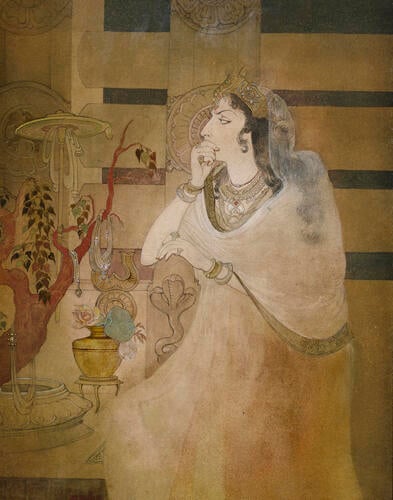-
1 of 253523 objects
Tissarakshita, Queen of Asoka 29 Dec 1911
25.0 x 18.9 cm (sight) | RCIN 452415

Abanindranath Tagore (1871-1951)
Tissarakshita, Queen of Asoka 29 Dec 1911
-
Queen Tissarakshita, three-quarter length, sitting in front of the railings of the Buddhist monument at Sanchi.
A note on the back of this painting gives the title ‘The Queen of Asoka’ and notes ‘King Ashoka was extremely fond of the Bodhi Tree – his Queen Tissarakshita became jealous of the sacred tree and in a fit of anger destroys it. Signed - A Tagore – completed on the 29th December 1911.’
The artist Abanindranath Tagore captures Tissarakshita’s mixed feelings of both triumph and regret as she stares at the wilting Bodhi tree, the jewels her husband sent it still hanging from its branches. The Queen thought that he was sending jewels to another women and realised too late that she had poisoned the scared tree.
Abanindranath Tagore pioneered the Bengal School, the first nationalist art movement in India. He grew up in Calcutta at the height of the Raj, surrounded by the imagery of Victorian and Edwardian Britain and didn’t encounter ‘traditional’ Indian painting until in he was in his twenties. This discovery came at a time of widespread questioning of power relations in both the intellectual and cultural spheres of Bengal which had enormous impact on his work.
Tagore was interested in looking back to the past: at themes from history and pre-colonial art. His main argument was that Indian artists should reject European academic art. Instead he took inspiration from Mughal and Rajput painting as well as contemporary Japanese and Chinese painting. Japanese artists of the early 20th century also reacted against Western art and it was from Yokoyama Taikan that Tagore learnt morotai, a hazy style of Japanese wash that became Tagore’s signature style.
Despite the nationalist roots of Tagore art, several of the leading cultural figures of British India endorsed his work including E.B. Havell, superintendent of the Government School of Art in Calcutta. Queen Mary admired Tagore’s work in an exhibition at the Calcutta Museum in early 1912 and noted in her diary that she ‘was particularly interested in the exquisite drawings’ she had seen (RA QM/PRIV/QMD: 4 January 1912). The Vicereine Lady Hardinge discerned her enthusiasm and presented The Queen of Asoka to Queen Mary as a gift before she left Calcutta.
Provenance
Given to Queen Mary by Lady Hardinge (wife of the then Viceroy of India) in Calcutta, January 1912.
-
Creator(s)
Acquirer(s)
-
Medium and techniques
Measurements
25.0 x 18.9 cm (sight)
34.7 x 28.2 cm (frame, external)
Object type(s)